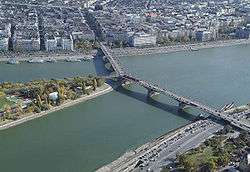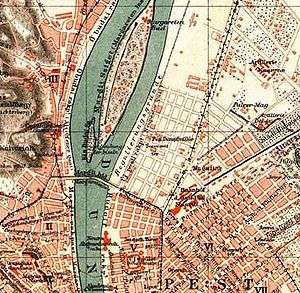Margaret Bridge
| Margaret Bridge | |
|---|---|
 Margaret Bridge, aerial photo | |
| Carries | two road lanes |
| Crosses | Danube River |
| Locale | Budapest |
| Official name | Margit híd |
| Characteristics | |
| Total length | 637.5 metres (2,092 ft) |
| Width | 25 metres (82 ft) |
| History | |
| Designer | Ernest Goüin |
| Construction begin | 1872 |
| Construction end | 1876 |
Margaret Bridge or Margit híd (sometimes Margit Bridge) is a three-way bridge in Budapest, Hungary, connecting Buda and Pest across the Danube. It is the second-northernmost and second-oldest public bridge in Budapest.
It was designed by French engineer Ernest Goüin and built by the construction company Maison Ernest Goüin et Cie. between 1872 and 1876, the engineer in charge being Émile Nouguier. Margaret Bridge is the second permanent bridge in Budapest after Széchenyi Chain Bridge. This bridge leads up to Margaret Island, its two parts enclosing 165 degrees with each other at the embranchment towards the island. The reason for this unusual geometry is that the small extension to connect to Margaret Island was hastily inserted into the original design but not built until two decades later due to lack of funds.
The bridge's two ends are
- Jászai Mari tér (northern end of Grand Boulevard) and
- Germanus Gyula park (stop of Szentendre HÉV; Lukács Baths and Király Baths are nearby).
It is 637.5 metres (2,092 ft) in length and 25 m in width.
Reconstruction
WWII
All the bridges of Budapest were blown up by World War II Wehrmacht sapper troops in January 1945 during their retreat to the Buda side of the surrounded capital. However, Margaret Bridge had been damaged by this time, on 4 November 1944, when an accidental explosion destroyed the eastern span of the bridge. 600 civilians and 40 German soldiers died. During reconstruction, much of the original steel material was lifted from the river and incorporated into the rebuilt structure.
2009–2011
The beginning of the 2000s, the bridge was in very bad shape. It became life-threatening, the reconstruction has become very important. The recondition (after the Megyeri Bridge and Szabadság Bridge completion) began 21 Aug. 2009. It was closed to road traffic for at least a year, but trams maintained partial service over the bridge using temporary track. The whole project took more than 20 billion forints and half of the costs are financed from EU funds. The restoration were completed in 2011. They tried to restore appearance of original bridge. Instead of reinforced concrete, durable steel was used and new barriers and floodlight were placed. The middle lanes wasa little bit widened, the sidewalk is expanded by approx. 2 meters and the bike path is completed.[1]
Cultural references
Soon after the bridge was inaugurated, it became a preferred spot for people seeking to take their own lives over personal or financial troubles. The wave of suicides inspired János Arany, a renowned Hungarian poet to compose a ballad, "Híd-avatás" (Bridge Inauguration), about the jumpers. It was widely distributed in leaflet format, illustrated with Mihály Zichy's romantic styled intricate pencil drawings.
Gallery
 1888 – the Bridge was not connected to Margaret Island, Ujlipótváros streets projected
1888 – the Bridge was not connected to Margaret Island, Ujlipótváros streets projected- 2009 – western section, southern side of Margaret Bridge
- 2012 - after renovation
- 2009 – structure of the connecting section to Margaret Island
- 2010 - renovation effort
- 2012 - after renovation
See also
| Wikimedia Commons has media related to Margit híd. |
References
External links
Coordinates: 47°30′53″N 19°02′37″E / 47.51472°N 19.04361°E